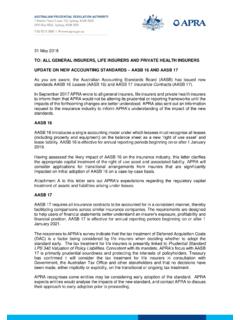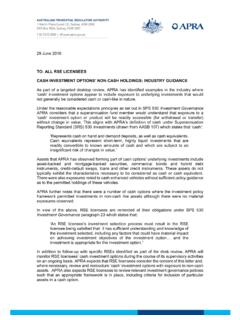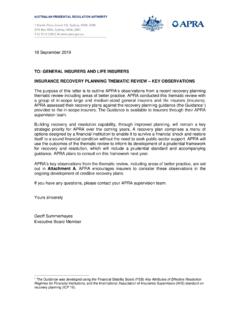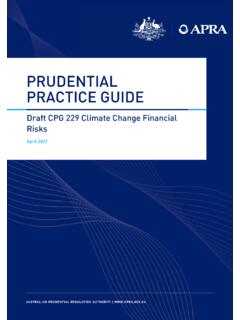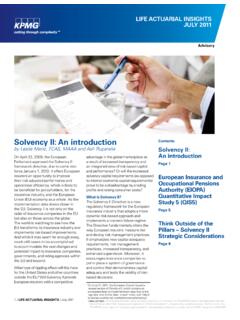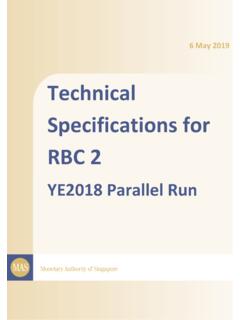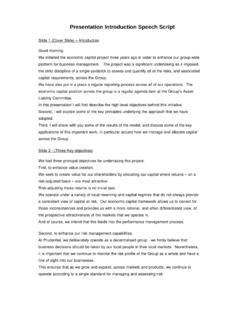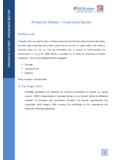Transcription of Climate Vulnerability Assessment
1 ININFORMFORMATATIIONON P PAAPPEERR Climate Vulnerability Assessment 3 SEPTEMBER 2021 AUSTRALIAN PRUDENTIAL REGULATION AUTHORITY 2 Disclaimer Text While APRA endeavours to ensure the quality of this publication, it does not accept any responsibility for the accuracy, completeness or currency of the material included in this publication and will not be liable for any loss or damage arising out of any use of, or reliance on, this publication. Australian Prudential Regulation Authority (APRA) This work is licensed under the Creative Commons Attribution Australia Licence (CCBY ). This licence allows you to copy, distribute and adapt this work, provided you attribute the work and do not suggest that APRA endorses you or your work. To view a full copy of the terms of this licence, visit AUSTRALIAN PRUDENTIAL REGULATION AUTHORITY 3 Contents Glossary 4 Executive summary 5 Chapter 1 - Assessing Climate risk 7 Climate change as a financial risk 7 Climate risk and APRA s supervisory activities 8 Climate Vulnerability Assessment 9 Chapter 2 - Key design features 10 The CVA and APRA s stress testing program 10 Climate scenarios 11 Tailoring the NGFS scenarios to the Australian context 13 Scope of the CVA 14 Prudential risk scope 15 Portfolio exposure scope for Climate risks 16 Mortgage exposures 16 Business exposure 16 Balance sheet approach 17 Counterparty assessments 18 Data quality Assessment 19 Chapter 3 - International Climate risk activities 21 Chapter 4 - Next steps 25 AUSTRALIAN PRUDENTIAL REGULATION AUTHORITY 4 Glossary ABA Australian Banking Association ADI Authorised Deposit-taking Institution APRA Australian Prudential Regulation Authority CFR Council of Financial Regulators (comprising APRA, the Reserve Bank of Australia.)
2 The Australian Securities & Investments Commission and The Treasury) Climate risk Financial risks arising from Climate change, including physical (both acute risks associated with extreme weather events; and chronic risks associated with gradual shifts in Climate ), transition and liability risks CPS 229 Prudential Practice Guide CPS 229 Climate Change Financial Risks CVA Climate Vulnerability Assessment GDP Gross Domestic Product GVA Gross Value Added NGFS Network for Greening the Financial System Paris Agreement Legally binding international agreement within the United Nations Framework Convention on Climate Change adopted by approximately 195 other countries representing a global political consensus to limit global warming to well below 2oC above pre-industrial temperatures Stress test Stress tests provide forward looking analysis and insight on the resilience of entities, industries and the financial system to current and emerging risks AUSTRALIAN PRUDENTIAL REGULATION AUTHORITY 5 Executive summary Climate change poses challenges to the stability and resilience of the financial system, including physical Climate risks arising from changing Climate conditions and extreme weather events.
3 Transition Climate risks associated with economic and technology change and social adaptation, and for Climate -related liability risks. Globally, central banks and supervisors are responding to these challenges, taking steps to understand and assess the financial risks of Climate change, and integrating Climate risk consideration into their existing financial stability and prudential supervisory activities. The Australian Prudential Regulation Authority (APRA) is tasked to ensure the financial safety of individual financial institutions and promote the stability of the Australian financial system. In particular, APRA is responsible for ensuring that, under all reasonable circumstances, the financial promises made by APRA-supervised institutions are met within a stable, efficient and competitive financial system. Given the potentially material and systemic nature of Climate -related financial risk, APRA has been giving greater attention to the financial risks of Climate change as part of its broader supervisory activities.
4 In April 2021 APRA released draft guidance for banks, insurers and superannuation trustees on managing the financial risks of Climate An aspect of this guidance was the value of using scenario analysis to underpin the quantitative analysis of the potential impacts of different future Climate scenarios on the performance of financial entities in Australia. The Climate Vulnerability Assessment (CVA), a Council of Financial Regulators (CFR) initiative led by APRA, has adopted this scenario analysis approach to assess the nature and extent of the financial risks that large banks in Australia may face due to Climate change. This information paper provides an overview of the CVA, as well as international activities relating to Climate scenario analysis and stress testing, including: 1. Objectives of the CVA: the three key objectives of the CVA are to assess potential financial exposure to Climate risk; to understand how banks may adjust business models and implement management actions in response to different scenarios; and to foster improvement in Climate risk management capabilities.
5 2. Key design features: the key design features of the CVA are outlined in this report, including the types of Climate risks considered, scope (geographic and financial exposures) of the Assessment , Climate scenarios, and the timeframe for the Assessment . 1 CPG 229 was open for consultation from 22 April 2021 to 31 July 2021. The draft guidance will be reviewed in light of stakeholder feedback, and issued as final guidance before the end of 2021. AUSTRALIAN PRUDENTIAL REGULATION AUTHORITY 6 3. International comparisons: recent examples of similar activities undertaken by international supervisors are summarised in this information paper. 4. Next steps: outline of the priorities for completing the CVA, as well as communication of the results and engagement with international peers. Climate risks have the potential to cause immediate financial risks to both financial and non-financial entities: as a result, a system-wide approach is best placed to address the potential impacts associated with this risk.
6 Achieving the objectives of the CVA will strengthen the understanding and management of Climate risk in the banking sector: however, the design approach taken for the CVA is also more widely applicable, including for the superannuation and insurance sectors, and may be of use to other non-financial enterprises in Australia. AUSTRALIAN PRUDENTIAL REGULATION AUTHORITY 7 Chapter 1 - Assessing Climate risk Climate change as a financial risk Climate change poses significant challenges for the global and Australian economy, and hence for the financial sector. The impact of Climate change has the potential to drive material and widespread changes to industries, markets and communities. These changes inevitably lead to increasing risks, as well as opening up new opportunities, for the economy, for financial and non-financial institutions, and for society more broadly. Organisations within the financial system need to consider where, how and to what extent the financial risks associated with Climate change will impact their business.
7 They will also need to consider how they will respond to the impacts of physical Climate events, an economic transition to a lower emissions economy, and the potential liability risks that may arise from Climate risk (Figure 1). Figure 1. Climate risks, opportunities and financial impact2 2 Adapted from Financial Stability Board Task Force on Climate -related Financial Disclosures, Final Report: Recommendations of the task force on Climate -related financial disclosures (June 2017) AUSTRALIAN PRUDENTIAL REGULATION AUTHORITY 8 The risks associated with a changing Climate also extend across many, if not all, sectors of the economy. Each sector will face its own challenges in understanding, assessing and managing the most material Climate -related risks. For firms in the finance sector, it will become necessary to understand not only their own businesses exposure to Climate -related risks, but also to assess the potential financial risks of Climate change of their customers and counterparties across a wide range of sectors, to build a comprehensive understanding of their Climate risk exposure.
8 Internationally, regulators and supervisors are increasingly focused on ensuring that Climate -related risks and opportunities associated are recognised within the finance system, and that decisions are made with the benefit of this knowledge. While the scope of APRA s draft Climate change financial risk guidance relates to all APRA-regulated sectors, the CVA is specifically focused on the banking sector. More broadly, initiatives undertaken by other CFR agencies relating to Climate risk may be relevant for, or transferable to, other sectors in the economy. Climate risk and APRA s supervisory activities Ensuring sound risk management and well-informed decisions is the driver of APRA s actions to increase industry understanding of, and resilience to, Climate -related risks. Mitigation of these risks aligns to APRA s objective of ensuring the financial safety of institutions and the stability of the Australian financial system. Delivering this outcome requires a considered and timely approach to Climate -related risks, both from industry and from the CFR agencies.
9 Alongside APRA s work to support industry understanding of Climate risk, there are a number of global actions and initiatives that have focused attention on the financial risks of Climate change. These include: the Paris Agreement, an international treaty with the goal of limiting global warming to well below 2 degrees Celsius compared to pre-industrial levels, driving significant government policy changes around the globe; the recommendations of the Taskforce on Climate -related Financial Disclosures (TCFD), which were developed to promote more informed investment, lending and underwriting decisions in response to Climate change; and senior legal opinion on the potential liability of company directors in Australia where risks associated with Climate change are not adequately managed. In addition to increasing international recognition of the material nature of Climate -related risks, there is increasing co-ordination of new standards and supervisory guidance to overcome challenges relating to methods, processes, tools and data availability to effectively measure, monitor and manage Climate risks.
10 International groups active in this area include the Network for Greening the Financial System, the IFRS Foundation, International Association of Insurance Supervisors, the Basel Committee on Banking Supervision and the Financial Stability Board. Through membership and engagement with these and other forums, APRA learns from and contributes its expertise to improving global understanding, and where relevant consistency, on Climate -related risks. AUSTRALIAN PRUDENTIAL REGULATION AUTHORITY 9 Against this backdrop, APRA has sought to ensure regulated entities are taking appropriate steps to understand and manage the financial risks associated with a changing Climate . Together with publishing its draft Climate change financial risk guidance in April 2020, APRA has taken the lead for CFR agencies in developing and undertaking the Climate Vulnerability Assessment . Climate Vulnerability Assessment As the first of its kind in Australia, but consistent with similar exercises being undertaken in a number of other jurisdictions, the CVA was initiated to better understand and quantify the potential financial impact of Climate change on banks under different but plausible Climate scenarios, and to improve understanding of the potential financial impact of the economic and Climate transitions under these scenarios.

